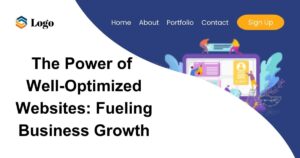There are three ways to start a website for your business: a website builder, a web design agency or a CMS. In this guide we’ll compare the three before looking at each one in turn.
Quick comparison: 3 ways to set up a website
Are you short on budget and want full creative control? A website builder is the cheapest way to get online and most are fairly simple to use.
By contrast, hiring a web design agency achieves the most professional results with minimal stress on your part and no IT know-how needed whatsoever.
If you’ve got a bit more technical expertise you’ll want to try a CMS for creating more precise functions.
The route you take depends on the cash, time, and knowledge at your disposal. Let’s look at the side-by-side comparison of each website type based on costs, difficulty and time to build:
| Method | Time | Cost | Difficulty |
|---|---|---|---|
| Website builder | 🕒🕒 | ££££ | ★★★★★ |
| Web design agency | 🕒 | ££££ | ★★★★★ |
| CMS | 🕒🕒🕒🕒 | ££££ | ★★★★★ |
Planning Your Business Website
Think about your user’s journey
This gives your website structure before you even start to build it. It’s about paving a comfortable path down which your user will walk. This involves thinking about where they will start. Is your landing page engaging enough to stop them bouncing straight away? Are the other pages on your website inviting? Well-signposted? Put yourself in the shoes of your user and let this guide your hand as you plan.
Draw inspiration from websites you love
Looking at websites of businesses in your niche is a great place to start. Study them and think about where they work and where yours can be better. Draw ideas from the structure and use this to plan your own website’s layout.
Consider your keywords
It’s likely you’re not spending time making your own website just for the fun of it. You want people to visit your site and engage with your business. This is why you need to think about how your audience will find you. Which means optimising your site for search engines like Google and Bing. Think about the words you’re customers will be using to find you and jot them down.
Expert Tip:
Always consider the look of your website from mobile devices. You may be creating your website on a desktop computer or laptop. But it doesn’t mean your user is viewing it that way! From your computer you can right click a page on your website and hit ‘Inspect’. Click the button that looks like a smartphone and it’ll reveal how your website looks when someone checks it out on a mobile.
Designing Your Business Website
Colour
It’s up to you to decide what looks good. It largely comes down to a mix of your personal taste and the kind of message you want to convey. If you have a logo or company colours you’ll want to theme the aesthetic of your website around them. Our tip: black and white always look good together. And a splash of a third brighter colour reflects your brand’s vibrant personality and adds energy!
Consistency
Keep crucial visual elements like font, headings and text size consistent across your site. Think about the experience of the user as they navigate the different pages of your site. Don’t make them feel as if they’re jumping around the web.
Cleanliness
Less is more. Don’t cram in blocks of text and give the user too much to look at. People tend to scan articles, so try to leave clean space around your text and images. The more you break up the content of a page, the more eyes will be drawn to your key message.
Contact
No matter what business you’re running, you’ll need your users to be able to get in touch. Your website should provide a contact form or your phone number. We recommend a bold and accessible form that doesn’t require too much info from the user. Do you have a newsletter and you want your user to subscribe? Leave a box where they can do this.
Sounds like hard work? Let professional web designers help you out. Click to receive up to four quotes from leading design companies.
Final steps
Connect a domain name
A domain name is the first step towards projecting a professional image to your online audience. If you’ve used a website builder, you can connect a domain name by upgrading to a paid plan. Find out how much your chosen domain name will set you back.
Optimise your site for SEO
Make sure your site can be found online. Whether you can successfully direct your target audience to your content will be the fine line between the make or break of your website. Make people click through to your website with concise and compelling statements. And If you’ve opted for a website builder like Wix, you’ll get a handy SEO plan to get you going.
Start creating powerful content
A big part of SEO is creating amazing content. Original, captivating content will boost your site up to the top of search engine pages. Whether it’s blog posts, informative articles, or reviews, content is king. And it’s a great way to form relationships with your readers and keep them coming back for more.
Enable analytics and start driving traffic
Once you’ve got your domain name sorted, it’s time to start analysing. Where are your visitors coming from? Who are they? CMS offer a bunch of superb plugins for analysing traffic. And website builders offer integration with Google Analytics once you’ve upgraded to a paid plan.
Jargon buster
Head spinning? The online world is full of mind-boggling terms, especially when it comes to website building. Let’s get to grips with a couple.
Domain
Put simply, this refers to everything that comes after “www.” in the name of your website. There are two parts of the domain name: the first part is usually a company or brand name, such as “expertmarket” and the second part, for example “.co.uk.” can signal where in the world your business is based or what kind of group you are. For instance, “.org” signals an official organisation, whereas “.edu” typically means an education facility and “.co” is often a trendy new start-up or tech company.
Hosting
This is the service of storing your website on a physical server so that it will appear on the world wide web. You can’t have a live website without that site being ‘hosted’ somewhere. There are different hosting services available depending on how much memory and bandwidth your website needs to run – for example, if your website has lots of images and videos or loads of monthly visitors.
Search Engine Optimisation (SEO)
SEO means making your website as visible as possible for people searching online. The results pages of search engines like Bing and Google are dense jungles, with thousands of websites jostling to appear above one another on the lists of articles displayed under certain search phrases. There are various strategies you can introduce to try and get your site above the others or you can hire a specialist SEO agency to undertake this for you.
Bounce Rate
If someone clicks to your page and doesn’t find what they’re looking for, they’ll leave straight away. This is called ‘bouncing.’ A bounce rate measures what portion of people are bouncing. A high bounce rate might mean your page doesn’t draw the reader in. So you could look at including more engaging writing or eye-catching images to invite people to read on.





